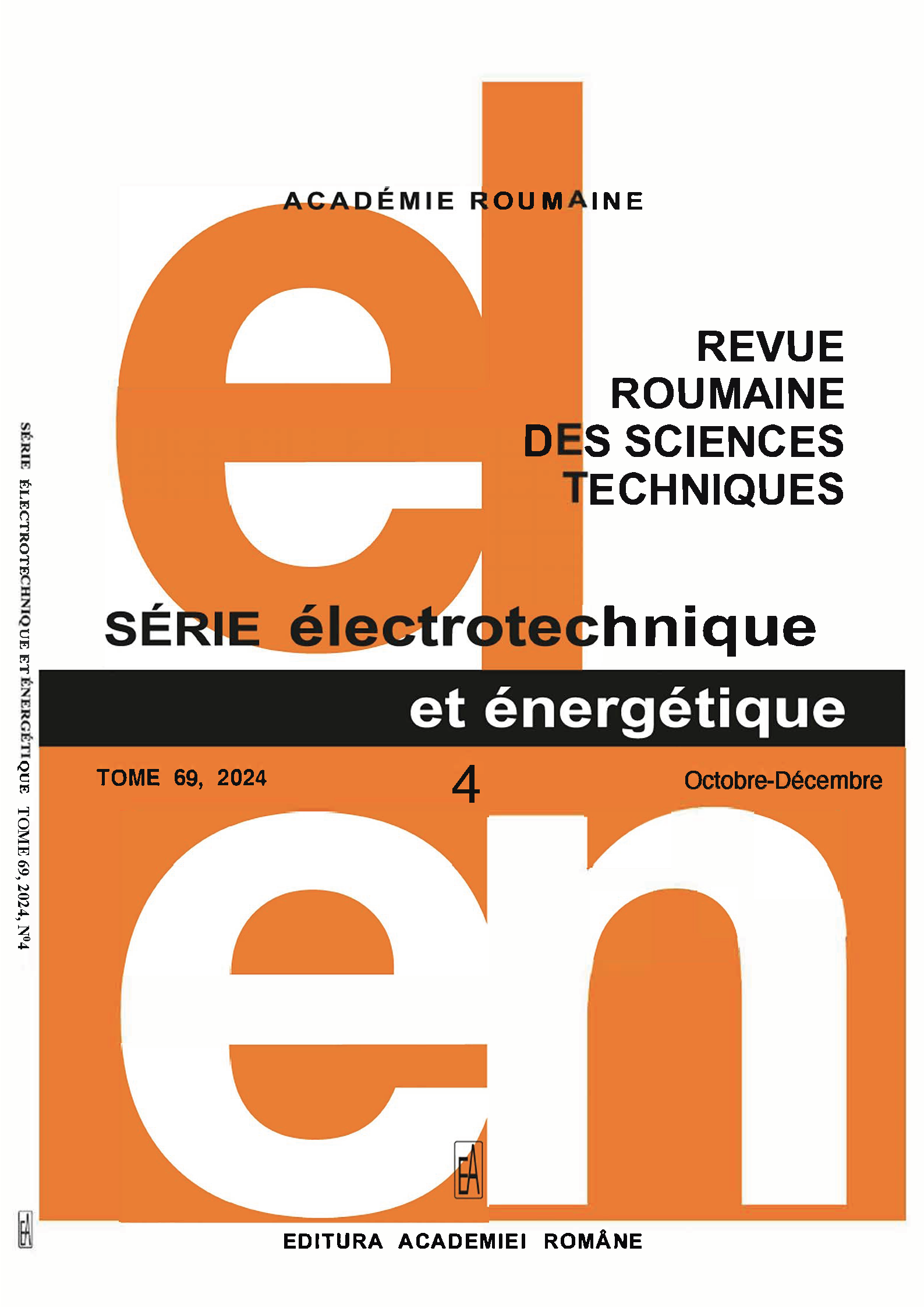COMMANDE COMBINÉE DE MODE COULISSANT DE PREMIER ET DEUXIÈME ORDRE DU MOTEUR À INDUCTION
DOI :
https://doi.org/10.59277/RRST-EE.2024.69.4.8Mots-clés :
Commande de moteur à induction, Contrôle du mode coulissant, Modélisation, Contrôle hybride, Phénomène de bavardageRésumé
Cet article utilise le contrôle du mode glissant hybride pour résoudre un problème de suivi de retour de sortie pour le moteur à induction (IM). L'idée principale de cette approche réside dans la conception d'une loi assurant une transition douce entre deux régimes de glissement basée sur le choix de deux surfaces de glissement, l'une étant liée à l'autre. La commande est une combinaison de modes glissants du premier et du second ordre. L'approche proposée contrôle la vitesse et l'amplitude du flux rotorique du moteur à induction et garantit la stabilité de la vitesse découplée et du flux rotorique en utilisant une méthode de Lyapunov. L'algorithme de mode glissant hybride offre une robustesse malgré les perturbations externes et les variations de paramètres. Le contrôleur a été implémenté sur une configuration expérimentale et les résultats sont présentés pour confirmer l'efficacité, la robustesse et les bonnes performances de la méthode proposée.
Références
(1) V.I. Utkin, Sliding mode control design principles and applications to electric drives, IEEE Trans on Industrial Electronics, 40, 1, pp. 23–36 (1993).
(2) V.I. Utkin, J. Guldner, J. Shi, Sliding mode control in electromechanical systems, Pub. Boca Raton. 2nd edition 2017. Taylor-Francis Group (2017).
(3) O. Barambones, A. Garrido, F. Maseda, Integral sliding-mode controller for induction motor based on field-oriented control theory, IET Control Theory Appl., 1, pp. 786–794 (2007).
(4) R. Rai, S. Shukla, B. Singh, Sensorless field oriented SMCC based integral sliding mode for solar PV based induction motor drive for water pumping, IEEE Trans. Ind. Appl., 56, pp. 5056–5064, (2020).
(5) A. Devanshu, M. Singhand, N. Kumar, Sliding mode control of induction motor drive based on feedback linearization, IETE Journal of Research, 66, 2, pp. 256-269 (2020).
(6) L. Gou, C. Wang, M. Zhou, X. You, Integral sliding mode control for starting speed sensorless controlled induction motor in the rotating condition, IEEE Transactions on Power Electronics, 35, 4, pp. 4105-4116 (2019).
(7) S.L. Yadav, S.S. Karvekar, Design of integral sliding mode controller for speed control of induction motor, In: 2022 2nd International Conference on Intelligent Technologies (CONIT), IEEE, pp. 1-6, (2022).
(8) P.J. Shaija, A.E. Daniel, Robust sliding mode control strategy applied to IFOC induction motor drive, In: 2021 Fourth International Conference on Electrical, Computer and Communication Technologies (ICECCT), IEEE, pp. 1-6 (2021).
(9) C.M. Oliveira, M.L. Aguiar, J.R. Monteiro et al, Vector control of induction motor using an integral sliding mode controller with anti-windup, J. Control Autom. Electr. Syst., 27, pp. 169–178 (2016).
(10) M.S. Mousavi, S.A. Davari, V. Nekoukar et al, Integral sliding mode observer-based ultra-local model for finite-set model predictive current control of induction motor. IEEE J. Emerg. Sel. Top. Power Electron., 10, pp. 2912–2922, (2021).
(11) M.H. Park, K.S. Kim, Chattering reduction in the position control of induction motor using the sliding mode, IEEE Trans on Power Electronics, 6, 3, pp. 317–325 (1991).
(12) A. Bennassar, S. Banerjee, M. Jamma et al, Real time high performance of sliding mode-controlled induction motor drives. Procedia computer science, 132, pp. 971-982, (2018).
(13) D. Zellouma, Y. Bekakra, H. Benbouhenni, Robust synergetic-sliding mode-based-backstepping control of induction motor with MRAS technique. Energy Reports, 10, pp. 3665-3680 (2023).
(14) I. Bendaas, F. Naceri, A new method to minimize the chattering phenomenon in sliding mode control based on intelligent control for induction motor drives, Serbian Journal of Electrical Engineering SJEE, 10(2), pp. 231-246, (2013).
(15) A. Levant, Sliding order and sliding accuracy in sliding mode control, International Journal of Control, 58, 6, pp. 1247-1263 (1993).
(16) A. Levant, Principles of 2-sliding mode design, Automatica, Elsevier Science, 43, pp. 576–586, (2007).
(17) T. Floquet, J.P. Barbot, W. Perruquetti, Second order sliding mode control for induction motor, 39th IEEE Conf. on Decision and Control, Sydney, Australia, 2, pp. 1691-1696, (2000).
(18) J. Mishra, L. Wang, Y. Zhu et al, A novel mixed cascade finite-time switching control design for induction motor. IEEE Trans. Ind. Electron., 66, pp. 1172–1181 (2018).
(19) F. Yeshiwas, S. Dereje, Fractional order sliding mode speed control of feedback linearized induction motor, Power Electronics and Drives, 5, 1, pp. 109–122 (2020)
(20) M. Zand, M.A. Nasab, M. Khoobani et al., Robust speed control for induction motor drives using STSM control, 12th Power Electronics, Drive Systems, and Technologies Conference (PEDSTC). IEEE, pp. 1-6 (2021).
(21) B. Wang, T. Wang, Y. Yu et al., Second-order terminal sliding-mode speed controller for induction motor drives with nonlinear control Gain, IEEE Transactions on Industrial Electronics, 70, 11, pp. 10923-10934 (2022).
Téléchargements
Publiée
Numéro
Rubrique
Licence
(c) Copyright REVUE ROUMAINE DES SCIENCES TECHNIQUES — SÉRIE ÉLECTROTECHNIQUE ET ÉNERGÉTIQUE 2024

Ce travail est disponible sous licence Creative Commons Attribution - Pas d'Utilisation Commerciale - Pas de Modification 4.0 International.


